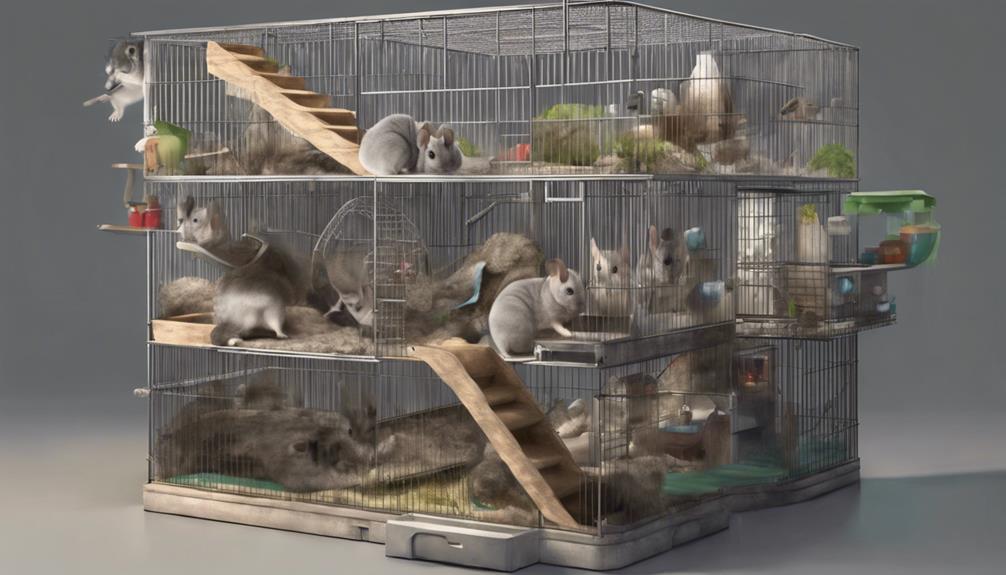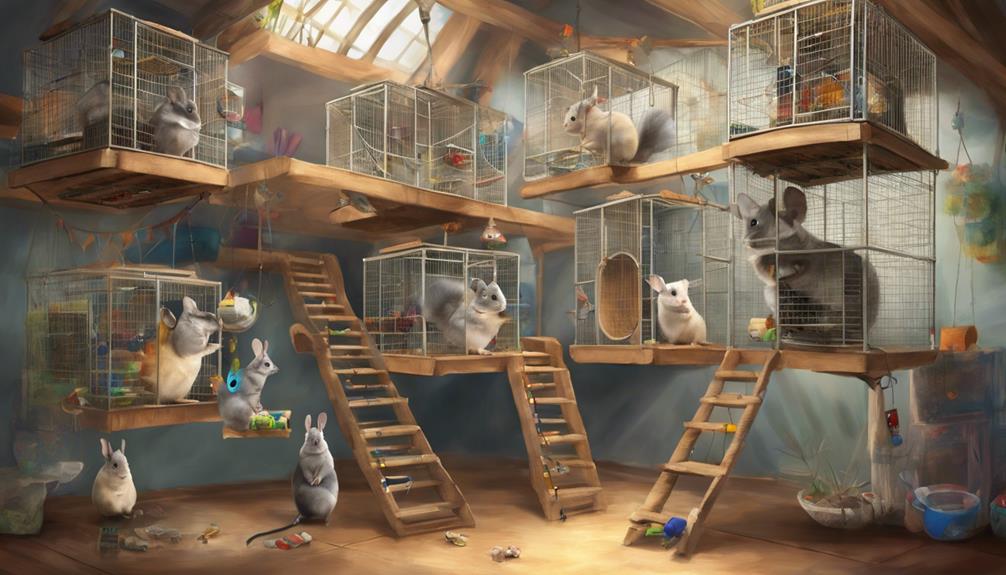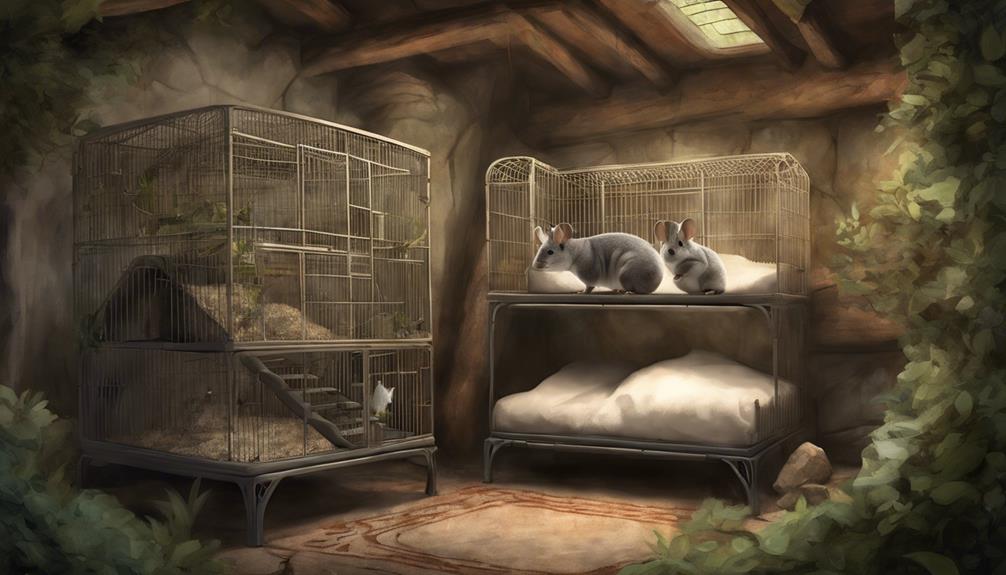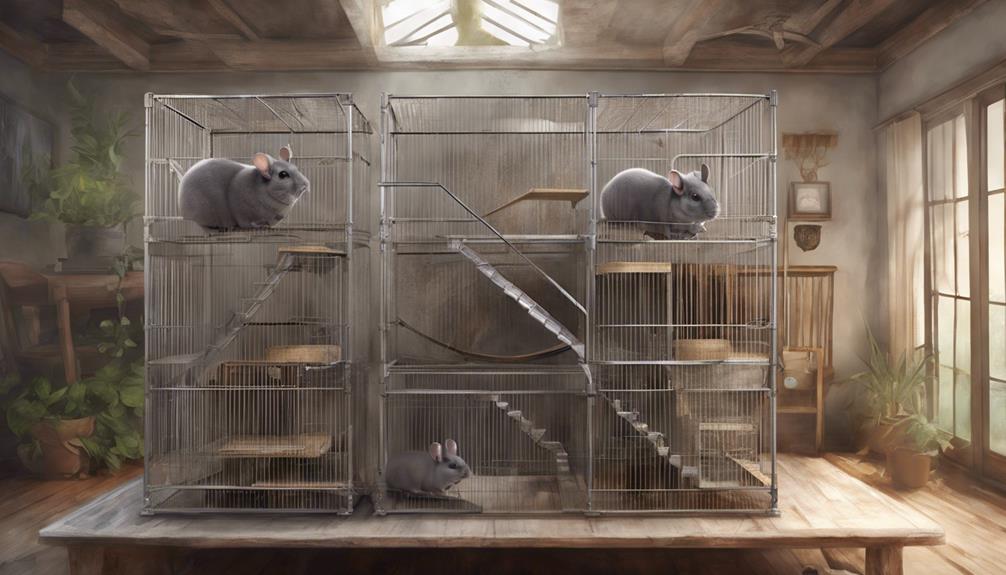How to Design a Custom Cage for Multiple Chinchillas

Designing a custom cage for multiple chinchillas requires careful planning to ensure the well-being of your pets. Here are some tips to create a happy habitat for your chinchilla companions:
- Size and Space: Chinchillas are active animals that require ample space to exercise and explore. The cage should be spacious enough to accommodate multiple chinchillas comfortably.
- Multi-Level Design: Consider a cage with multiple levels to provide vertical space for your chinchillas to climb and jump. This will enrich their environment and encourage natural behaviors.
- Chew-Proof Materials: Chinchillas have a natural instinct to chew, so it's essential to use chew-proof materials for the cage construction. Avoid plastic or any toxic materials that could harm your pets.
- Dust Bath Area: Chinchillas need regular dust baths to maintain their fur health. Incorporate a designated dust bath area in the cage with chinchilla-safe dust for their grooming needs.
- Proper Ventilation: Ensure good air circulation in the cage to prevent respiratory issues. Adequate ventilation is crucial for the overall health of your chinchillas.
- Nesting and Hideouts: Provide cozy nesting areas and hideouts for your chinchillas to rest and feel secure. Include soft bedding material for their comfort.
- Toys and Enrichment: Keep your chinchillas mentally stimulated by adding toys, tunnels, and other enrichment items to the cage. This will prevent boredom and promote their well-being.
By implementing these tips and designing a custom cage that meets the specific needs of your chinchillas, you can create a happy and healthy habitat for your furry companions.
Key Takeaways
- Consider cage size and multi-level design for space and enrichment.
- Use chew-proof materials and ensure proper ventilation for respiratory health.
- Provide dust bath area and control temperature/humidity for comfort.
- Implement cleaning routines, enrichment activities, and safety measures for multiple chinchillas.
Proper Ventilation and Airflow
Ensuring adequate ventilation and airflow within a custom cage for multiple chinchillas is essential for their overall health and well-being. Proper air circulation and filtration help maintain a fresh and clean environment, reducing the risk of respiratory issues and ensuring a comfortable living space for these furry companions. Temperature regulation and humidity control are also vital factors to contemplate when designing the chinchilla habitat.
Space and Layout Considerations
When designing a custom cage for multiple chinchillas, one must carefully consider the size of the enclosure and how it will accommodate the needs of all the furry occupants.
Additionally, the layout of the cage, including the organization of levels and platforms, plays a vital role in providing an enriching environment for the chinchillas to explore and enjoy.
Cage Size Planning
Crafting a suitable living space for multiple chinchillas requires meticulous attention to detail, particularly when considering the dimensions and layout of the cage.
When planning the cage size, keep these key points in mind:
- Space Guarantee: Guarantee the cage provides ample room for each chinchilla to move freely, play, and exercise. Consider the number of chinchillas sharing the space to determine the appropriate size.
- Cage Flooring: Choose flooring options that are safe, non-toxic, and easy to clean. Opt for materials like fleece liners or kiln-dried pine bedding to keep your chinchillas comfortable.
- Climbing Structures: Incorporate various climbing structures like shelves, ramps, and platforms to enrich your chinchillas' environment and encourage their natural behaviors. These structures also help utilize vertical space effectively.
Organization of Levels
To optimize the living space for multiple chinchillas, carefully strategize the arrangement of levels within the cage, considering both spatial requirements and layout dynamics. Guarantee level accessibility and provide various climbing options to keep your chinchillas engaged and active.
Utilize the floor space wisely, creating ample running areas for them to exercise and explore. By incorporating different levels with easy access points, you allow your chinchillas to move freely and prevent boredom. Remember that a well-organized cage not only provides physical stimulation but also promotes mental well-being for your furry friends.
Keep the layout dynamic, offering a mix of heights and spaces to cater to your chinchillas' natural instincts and desire for movement.
Enrichment Activities and Toys

When it comes to keeping multiple chinchillas entertained and happy, choosing the right toys and enrichment activities is key.
From selecting the safest toys to crafting engaging DIY enrichment ideas, there are various ways to stimulate these intelligent creatures.
Toy Selection Tips
Selecting the right toys for your chinchillas can greatly enhance their physical and mental well-being, promoting a happy and active lifestyle. When choosing toys for your furry friends, consider the following tips:
- Material Durability and Chew Resistance: Opt for toys made from sturdy materials like wood or metal that can withstand the incessant nibbling of chinchilla teeth.
- Size Variety and Activity Options: Offer toys of different sizes and shapes to stimulate various natural behaviors such as climbing, chewing, and hiding.
- Interactive Toys: Include toys that encourage interaction and play, such as tunnels, exercise wheels, or puzzle feeders, to keep your chinchillas engaged and entertained.
DIY Enrichment Ideas
Enhance your chinchillas' lives with engaging DIY enrichment activities and toys that cater to their natural instincts and behaviors.
DIY climbing structures provide a fun way for chinchillas to exercise and explore, satisfying their urge to climb and jump. Incorporating sensory play elements like different textures and scents can secure their senses and keep them entertained.
Remember to chinchilla-proof the toys and structures to make certain they're safe for play. Bonding exercises, such as hand-feeding treats or gentle petting sessions, can strengthen the bond between you and your chinchillas.
Multi-Level Design for Exercise
Crafting a multi-level habitat encourages chinchillas to engage in natural climbing behaviors, promoting their physical fitness and mental stimulation. To design an enriching space for your chinchillas, consider the following:
- Vertical Platforms: Incorporate various levels within the cage using ramps, shelves, or ladders. This provides opportunities for chinchillas to climb and explore, mimicking their natural habitat.
- Hammocks and Ledges: Adding hammocks or ledges at different heights offers resting spots and encourages jumping and balancing activities, engaging multiple chinchillas simultaneously.
- Chew Toys and Treat Stations: Place chew toys and treat stations strategically across different levels to entice movement and exploration. This not only promotes exercise but also mental stimulation as chinchillas forage and play.
Hiding Spots and Retreat Areas

For a welcoming and secure environment that nurtures their natural instincts, consider incorporating cozy hiding spots and retreat areas within the chinchilla habitat. Chinchillas, known for their playful and curious nature, thrive in environments that offer them a variety of cozy nooks and play areas to explore. These relaxation spots provide them with a sense of security and comfort, allowing them to retreat and unwind whenever they feel the need.
Exploration zones are essential for chinchillas to satisfy their innate desire to investigate new surroundings. By incorporating tunnels, cardboard boxes, or wooden houses within their habitat, you can create stimulating environments that encourage their natural behaviors. These areas not only serve as hiding spots but also double up as exciting play areas where chinchillas can exercise their bodies and minds.
Easy Cleaning and Maintenance
How can one efficiently maintain and clean a custom cage designed for multiple chinchillas? Keeping the chinchilla's habitat clean is vital for their health and well-being. Here are some tips to make cleaning and maintenance a breeze:
- Odor Control Solutions: Utilize natural odor control solutions like baking soda or specialized chinchilla-safe deodorizers to keep the cage smelling fresh between cleanings. Regularly changing bedding and spot-cleaning soiled areas can also help in controlling odors.
- Cage Material Options: Choose cage materials that are easy to clean and maintain, such as metal wire cages with removable trays or plastic cages that can be wiped down easily. Avoid materials that absorb odors or are difficult to clean thoroughly.
- Maintenance Tips: Develop a cleaning schedule to regularly clean the cage, including washing food and water dishes, cleaning toys, and replacing bedding. Regularly inspect the cage for any signs of wear or damage that may need repair or replacement to guarantee a safe and clean environment for your chinchillas.
Safety Measures and Escape Prevention

To enhance safety and prevent potential escapes, consider incorporating sturdy locks on all access points of the custom chinchilla cage. Chinchillas are curious and agile creatures known for their climbing abilities. Hence, providing secure climbing structures within the cage can offer both entertainment and exercise while ensuring the chinchillas remain safe.
Additionally, implementing safety features like rounded edges and non-toxic materials is vital to prevent any harm to your pets.
Chinchilla proofing the cage involves checking for any small gaps or holes where these tiny animals could squeeze through. Regular maintenance and inspection of the cage can help identify and address any potential escape routes. It's important to prioritize the safety of your chinchillas by creating a secure and escape-proof environment for them to thrive.
Frequently Asked Questions
Can Chinchillas Live Together in the Same Cage?
Chinchillas can live together in the same cage if their social dynamics align. Understanding chinchilla behavior is key to fostering a harmonious environment. Observing their interactions and providing ample space and resources can promote a peaceful cohabitation.
How Often Should the Cage Be Cleaned and Sanitized?
Keeping the cage clean is crucial for the chinchillas' health. Regular cleaning, such as weekly spot cleaning and monthly deep cleaning, prevents odors and bacteria buildup. Use pet-safe disinfectants like vinegar or specialized cage cleaners to sanitize effectively.
What Materials Are Safe for Constructing a Chinchilla Cage?
When considering materials for constructing a chinchilla cage, guarantee safety by choosing non-toxic options like kiln-dried pine or aspen for cage flooring. Custom cage designs should prioritize sturdy wire mesh and secure locks for durability and security.
Are There Any Specific Temperature Requirements for Chinchilla Cages?
Regulating temperature in a chinchilla cage is essential. Proper ventilation aids in maintaining an ideal environment. Ensuring a consistent temperature between 60-70°F is recommended. Avoid drafts and direct sunlight. A thermometer can help monitor conditions accurately.
How Can I Prevent My Chinchillas From Chewing on the Cage Bars?
To prevent chinchillas from chewing on cage bars, provide ample chinchilla enrichment like chew toys and wooden accessories. Distract them from the bars by offering various textures and activities. Keep those curious critters engaged and happy!











